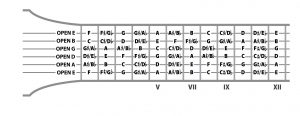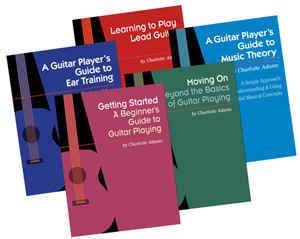When it comes to understanding music and the guitar, a little knowledge can go a long way. A Guitar Player’s Guide to Music Theory provides a painless and effective way to learn the information that is relevant to guitar players. You can see sample pages here.



The distance from any one note to the other is called a half step (½ step). The distance from one fret to the next on your guitar is ½ step. With this information, you can find any note on your guitar by starting with an open string and going up, one fret at a time, naming the notes as you go.

How to Tune a Guitar Using the Relative Tuning Method
6th string: Establish a satisfactory pitch for the 6th string (the lowest, thickest string) The note should be “E”, but if you don’t have a tuner, tuning fork or constant pitch instrument to help you establish that pitch, just do your best to find a note in the range that you feel is correct. Even if you don’t tune to “E” your guitar will sound in tune when you’re finished, because you will be tuning all of the strings relative to this one.
5th string: Press on the 5th fret of the 6th string and listen to the note produced when you strike the string. Next, play the 5th string open and tune it to match the sound of the fretted 6th string. Don’t worry if it’s difficult for you to hear whether the 5th string is too high or too low. You will get better at discerning pitches with practice. It can help to sing the two pitches and feel your voice go up or down. It can also help to listen to the vibration of the two pitches and try to make them match.
4th string: You will follow the same method for the remainder of the strings. Press at the 5th fret of the 5th string and compare that sound to the 4th string open. Alter the 4th string as necessary.
3rd string: Repeat the procedure for 3rd string, comparing the sound of the 4th string played at the 5th fret with the sound of the open 3rd string.
2nd string: This one is slightly different. Press on the 4th fret of the 3rd string and compare that sound to the 2nd string open.
1st string: Now you can go back to the “normal” way: Press at the 5th fret of the 2nd string and compare that sound to the 1st string open.
Once you get the strings close to the pitch you want, avoid making big changes in the pitch. Some people habitually take the string very low in pitch and then bring it up in order to hear it more easily. That method can be problematic, as the extreme loosening and tightening of the string may change the tension on the neck, which can throw the already tuned strings out of tune! If you choose to use this method, go back and fine-tune the whole guitar using subtle adjustments before playing.
Learn how to find notes and chords on the fretboard quickly with the downloadable video Fretboard Familiarity.
Want something good for free? (This is completely free – you will never be put on any list, you won’t see any advertising and you will never receive solicitations.) Sign up here and receive free, quality instruction in your mailbox each Tuesday morning.
Ready to learn more? Find books, videos, t-shirts, practice aids and lessons for every guitar player here!
Eat, Sleep, Play. Guitar Instruction by Charlotte Adams

